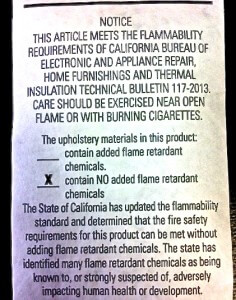July 2015: Can we shop our way out?
In this edition:
- Happiness is a new couch…without flame retardants!
- Your sofa may be safer, but your insulation is still a PRoblem
- “Six Classes” retreat contributes to reduced toxics

Can educated consumers shop their way out of the toxic chemical problem? Not so easily, because most products aren’t required to list the chemicals they contain. Even when they do, who has the time and expertise to decipher complex labels? Large purchasers can have a big impact on this issue: they can require manufacturers to give them more information about chemicals in products and shift the market towards healthier products with reduced toxics. The excellent news is that a number of the largest companies in California are now coming together to use their collective buying power to purchase healthier products. We worked with some of these companies to help facilitate this during our recent Six Classes Toxic Reduction. Our group photo is on the right.
Our new objective is to reduce the use of some or all the Six Classes containing chemicals of concern in consumer products by 50% in the next five years. As educated large purchasers, manufacturers, retailers, and designers make better buying choices, this ambitious goal seems achievable. I was delighted to learn that a large U.S. retail chain stopped the use of flame retardants and stain repellants – two of the Six Classes of concern – on July 1, 2015. A major international retailer was first, this U.S. chain is second, and others should follow. This is a big step towards a healthier population and planet.
Other good news is that Caroline, our Director of Development, was finally was able to buy a couch without flame retardants, and you can too. Her story is below. We have heard from the foam industry that flame retardants are no longer being used in most of the furniture foam they manufacture. That means after the old furniture is sold off, new furniture will not contain these harmful chemicals – such good news!
After replacing furniture containing flame retardants with new furniture without them, levels of these chemicals in our dust and our bodies should go down. (The levels in my dust went from 97ppm to 3ppm three years after I swapped out all my furniture with flame retardants.) See below if you might like to apply to participate in a research study to measure this decrease in your home.
This Sunday, the Institute will host a day-long symposium in Colorado on the Science and Policy of Highly Fluorinated Chemicals with about sixty international scientists. We are looking forward to learning more about this class of chemicals, which lasts for geologic time and is potentially harmful, as well as encouraging the scientists to use their research results to reduce non-essential uses.
Have a fun summer,
Arlene and the Green Science Policy team
Happiness is a new couch…without flame retardants!

In 2012, when I started working at the Green Science Policy Institute, I learned that our decrepit couches contained flame retardants that could contribute to health problems and didn’t provide a fire safety benefit. I wanted to replace these old couches right away, but had to wait for the new TB117-2013 standard.

How long did I have to wait? 3 years! When my husband and I recently bought a new couch, I wanted to be sure it wouldn’t contain any flame retardants. The store manager emailed me a copy of the couch label stating “contains no added flame retardant chemicals.” Yay! Now we have a new couch without flame retardants and everyone is happy – apart from the dogs, who are not supposed to jump up (but still do).
And in case you missed it, here’s an editorial called My New Sofa from ES&T about our work leading to the editor’s new couch and the value of scientists sharing their research results with decision makers.
Your sofa may be safer, but your insulation is still a PRoblem

The title of a recent Guardian article says it all: “Quest to eliminate chemical flame retardants from Californian homes is far from over.”
A 2013 Bill required the California State Fire Marshal to consider and possibly propose updates to California building codes. This could have reduced the unnecessary use of harmful flame retardant chemicals, like HBCD, in building insulation. Unfortunately, the July 1, 2015 deadline imposed by that bill has passed; and the report of the working group formed to evaluate such updates has not been finalized.
Our 2012 peer-reviewed paper makes the case for updated flammability standards for foam plastic insulation materials. Even though the state of California has dragged its feet, a diverse coalition continues to work to update codes. Our proposed changes to the International Building Code would allow foam plastic insulation below grade – where there is no fire hazard – to be used without flame retardant chemicals.
Read more about flame retardants in building insulation and our ongoing efforts at SaferInsulation.org.
“Six Classes” retreat contributes to reduced toxics
For a third year, diverse participants came together for four days in an inspiring natural setting to discuss reducing the use of classes of harmful chemicals. Representatives from Google, Kaiser, Ikea, Facebook, Salesforce, HP and Interface, as well as universities, non-profits, and government developed strategies to incorporate the class concept into their work towards healthier building materials and consumer products. One focus was for large purchasers to require disclosure of chemicals in products and use their collective buying power to reduce harm. You can learn more about chemical classes of concern and listen to informative short webinars at www.SixClasses.org.
Receive Updates By Email
Subscribe to our monthly newsletter and get these updates delivered right to your inbox!